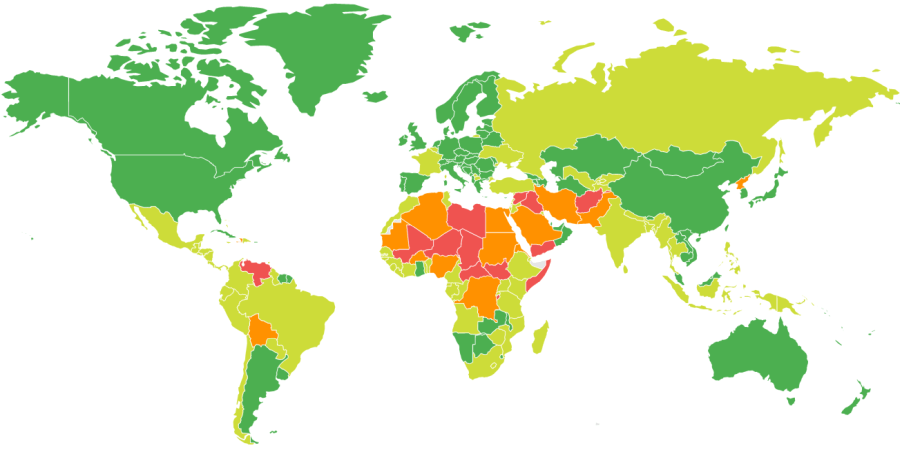
Saint Kitts and Nevis Travel Safety
Travel Safety in Saint Kitts and Nevis
General travel safety in Saint Kitts and Nevis on a scale of 1 to 4 — where 1 is safe and 4 is dangerous. Data compiled on the basis of Canadian Department of Foreign Affairs.
Country
Saint Kitts and Nevis
Updates
Updated: 26 Jun 2025 • Still current at: 2 Jul 2025
Status
LEVEL 1 - Exercise normal safety precautions
Use common sense and look out for suspicious behaviour. Monitor the media and other sources for changes to local travelling conditions, safety and security concerns. Laws and social customs could differ significantly. You could face terrorist attacks, civil unrest, violent crime, or unique health threats - but overall, the risks are not great.
Safety and Security Tips
Road safety
Road conditions vary and can be poor in remote areas. Pedestrians tend to walk on the road and drivers often fail to signal. When renting a car, make sure the rental company offers 24/7 roadside assistance.
Swimming
Coastal waters can be dangerous. Follow the instructions and warnings of local authorities.
Taxis
Taxis are available on both islands. Taxis are not metered, so agree on the price of the fare with the driver before leaving. At the airport, ask about pre-established fares and agree with the driver on the amount to be paid.
Women's safety
Saint Kitts and Nevis is generally safe, however women should exercise normal precautions during travel.
Crime
Petty crime and violent crime, such as armed robbery and sexual assault may occurs on Island. Avoid isolated areas and unpatrolled beaches after dark. Ensure that your personal belongings, including passports and other travel documents, are secure at all times.
Update 1 November 2020Emergency Calls
- Police911
- Fire911
- Ambulance911
Local Law and Culture
LGBT
Saint Kitts and Nevis law prohibits certain sexual acts between individuals of the same sex. LGBT travellers should carefully consider the risks of travelling to Saint Kitts and Nevis.
Illegal or restricted activities
Penalties for possession, use or trafficking of illegal drugs are severe. Convicted offenders can expect large fines or imprisonment. It is illegal, even for children, to dress in army or camouflage clothing or carry items made of camouflage material.
Driving
Traffic drives on the left. You need a local driving permit to drive in Saint Kitts and Nevis. You can obtain one for a fee from the fire station in Basseterre in Saint Kitts or any police station in Nevis, upon presentation of a valid driver's licence.
Update 1 November 2020Vaccinations and Medications
A doctor's consultation is required prior to any vaccinations being administered. This section is for informational purposes and does not exhaust all issues related to vaccination. Please contact your doctor for complete information on this subject.
Stay Healthy and Safe
Act in advance of to prevent. Check the vaccines and medicines list and visit your doctor at least 4-8 weeks before your trip to get vaccines or medicines you may need.
All travelers
You should be up to date on routine vaccinations while traveling to any destination. Some vaccinations may also be required in Saint Kitts and Nevis.
Before each trip, it is worth making sure that we are up to date with the routine vaccinations. These include vaccinations against measles, mumps and rubella, diphtheria, tetanus, whooping cough, chickenpox, polio and flu.
Prevention
- Get vaccinated
- Reduce your exposure to germs
Most travelers
Get travel vaccines and medicines because there is a risk of these diseases in the country you are visiting.
Hepatitis A is a digestive disease caused by the hepatitis A virus and is closely related to a lack of good hygiene.
It can be asymptomatic, moderate, or very severe.
Prevention
- Get vaccinated
- Eat and drink safely
Typhoid fever is an acute, systemic infectious disease caused by Salmonella typhi.
The source of the infection may include dirty water, raw fruits, vegetables, dairy products, as well as dirt containing bacteria.
Prevention
- Get vaccinated
- Eat and drink safely
Some travelers
Vaccinations and medications that may be recommended under certain conditions, depending on where you will be, the length of your stay and the nature of your stay.
Hepatitis B is a disease caused by the hepatitis B virus.
Infection occurs through contact of injured skin or mucous membranes with virus-infected blood or other secretions (e.g. during sexual contact, through contaminated needles or as a result of medical procedures).
Prevention
- Get vaccinated
- Avoid sharing body fluids
- Avoid non-sterile medical or cosmetic equipment
Rabies is an acute infectious disease caused by neurotrophic viruses from the rhabdovirus family.
The infection is most often caused by biting a sick animal or other contact of its saliva with mucous membranes, conjunctiva or damaged skin.
Prevention
- Get vaccinated
- Keep away from animals
Yellow fever is an acute viral disease which is transmitted by virus-infected mosquitoes.
Prevention
- Get vaccinated
- Prevent bug bites
Vaccination requirements
Required if traveling from a country with risk of YFV transmission and ≥1 year of age.
We have made every effort to ensure that the information presented reliably reflects the general safety situation in a given place. However, the data is provided for informational purposes only and we do not take responsibility for any damages or losses resulting from incorrect risk assessment. Before each trip, we recommend checking the current situation in the country of destination on the websites of the relevant Ministry of Foreign Affairs.
